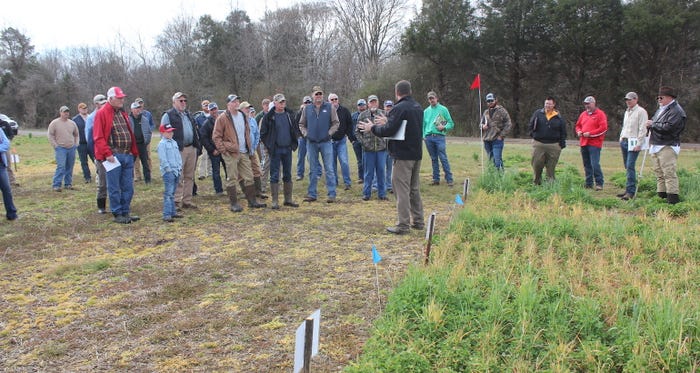
This season’s war on weeds has already begun, although farmers are going into the fight with less ammunition than previous years.
Glyphosate and glufosinate supplies are tight. Growers have reported trouble sourcing 2,4-D and dicamba, and even some Group 15 herbicides such as Dual Magnum, Warrant and Zidua are becoming hard to find. Producers have seen the herbicides they can find skyrocket in price.
“The average cost of applying burndown has jumped from roughly $9.50 an acre last year to more than $23 this year,” said Mike Clayton, sales and marketing manager with First Farmers Co-op in Henderson, Tenn.
Clayton was speaking at a recent field day hosted by First Farmers that showcased herbicide burndown trials. The combination of high costs, supply chain issues and the increasing number of weed species with herbicide resistance have made 2022 burndown decisions particularly challenging. Dozens of farmers turned out, eager to see which burndown tankmixes would most effectively (and perhaps economically) terminate cover crops and spring weeds, like poa annua.
The field trials were performed on the Essary-Cherry Farm in Enville, Tenn. Brothers-in-law Kevin Essary and Jason Cherry were pleased to see that their go-to burndown mix was one of the best in the trials: 30 ounces of Roundup Power Max 3, 7.5 ounces of Verdict, 9.6 ounces of Destiny HC and 16 ounces of Class Act.

“We use it across our farm,” Essary said. “This tankmix provides a good residual and good control of poa.”
Burndown challenges
In Tennessee, producers have seen sketchy control of poa and ryegrass with the commonly used glyphosate + dicamba tankmix, according to University of Tennessee Weed Scientist Larry Steckel.
“There are two reasons for that,” Steckel said. First, the continued evolution of glyphosate resistance in poa and ryegrass populations has made the most common burndown tankmix very inconsistent. Second, we have now documented that dicamba is consistently causing glyphosate to provide poor grass control. As such our recommendation has been to change the “go-to” burndown from glyphosate + dicamba to glyphosate + clethodim.”

“The problem with using glyphosate + clethodim is that the burndown will miss or be weak on some broadleaf weeds, most notably glyphosate-resistant horseweed,” Steckel added.
Steckel’s research suggests Verdict does not antagonize glyphosate’s control of ryegrass. Adding it to the tankmix, typically provides pretty good poa control, as well. (There is a six-month plant back to cotton following a Verdict application.)
Other options to replace 2,4-D and dicamba are Elevore and Reviton. Elevore is a fairly new burndown option that is in the auxin-mimic herbicide mode of action. Steckel has not observed grass antagonism when Elevore is mixed with glyphosate.
Reviton is the new PPO-inhibiting herbicide for the burndown window. It has provided good control of henbit and other winter annual broadleaves when tankmixed with glyphosate or clethodim in UT trials.
“These studies suggest that Elevore or Reviton should very ably replace dicamba in a burndown application without imposing appreciable loss of poa or ryegrass control from glyphosate and/or clethodim,” Steckel said, adding that plant back to soybean and cotton with Reviton is 14 days. The plant back with Elevore for corn is 3 days, 14 days for soybean and 30 days for cotton.
Finding ways to save?
Even if you can source the most effective products to fight off resistant weeds, will the higher costs of herbicides in 2022 provide a positive return on investment? And is it better to conserve product to be sure you have enough for post applications?
When Essary and Cherry were asked if they were going to modify their early season weed control practices to either save money or conserve product, they responded with a decisive no.

“If you skimp on weed control now, it’s about to eat your lunch,” Cherry said. “This is not the year to cut corners. We want to do it right the first time.”
While the Essary-Cherry family are not planning to modify their burndown, many growers throughout the Northern Delta are considering changes — either to cut costs or save product for post applications.
“We try to talk them down from that,” said Ryan Zawacki, agronomist with First Farmers. “You may save money now, but you’ll have problems later. Early season weed control should be the top priority to avoid reductions in crop yield.”
Research from Michigan State University suggests that yield losses of up to 7 bu/a are possible in soybeans when weeds are not controlled until the unifoliate stage (VC) compared to controlling early season weeds prior to or at planting.
Waiting to control these weeds when soybean is at the V1 stage (first trifoliate) can reduce yield approximately 0.5 bushel per acre per day. In our current market, this could lead to approximately $38 per acre reduction in profits at the end of the season.
Lessons from Louisiana
About 400 miles south of the Essary-Cherry Farm, Daniel Stephenson, weed scientist with LSU AgCenter has already observed weed control complications when farmers strayed from their typical burndown tankmixes. Whether they couldn’t get it or were trying to save supply, some growers left glyphosate out of the tank, replacing it with paraquat. Stephenson said the results were not good.

Daniel Stephenson, weed scientist with LSU AgCenter. (Ginger Rowsey)
“Paraquat applied at burndown did not resemble what we see in August and September applications of paraquat, because it is more effective when applied at high temperatures and high humidity,” Stephenson said.
“We didn’t realize what glyphosate did for us,” he continued. “With its removal we saw very poor control with numerous weed species, particularly henbit. Even driving down the road at 60 miles an hour, you can easily determine fields that did not receive a glyphosate application.”
While growers’ hands are tied in many cases, Stephenson is encouraging farmers to keep an eye on the future to ward off additional resistance issues.
“Producers should focus on weed control fundamentals that encourage maximum efficiency. Use the correct herbicide rate. Apply timely to weeds at the correct size. Use proper water volume and apply under proper weather conditions,” he said.
“If you’re using glyphosate, include ammonium sulfate in the tank, especially if you have hard water, to maximize its efficacy (although not when tankmixed with dicamba or 2,4-D).
Residuals will be essential.
“Every time you go across the field, you need a residual in the tank,” he added. “And please, if you have an escape, go physically remove it from the field and burn it.”
“It’s going to be a battle and there will be little room for error this year. We have to rely on weed management fundamentals.”
About the Author(s)
You May Also Like






